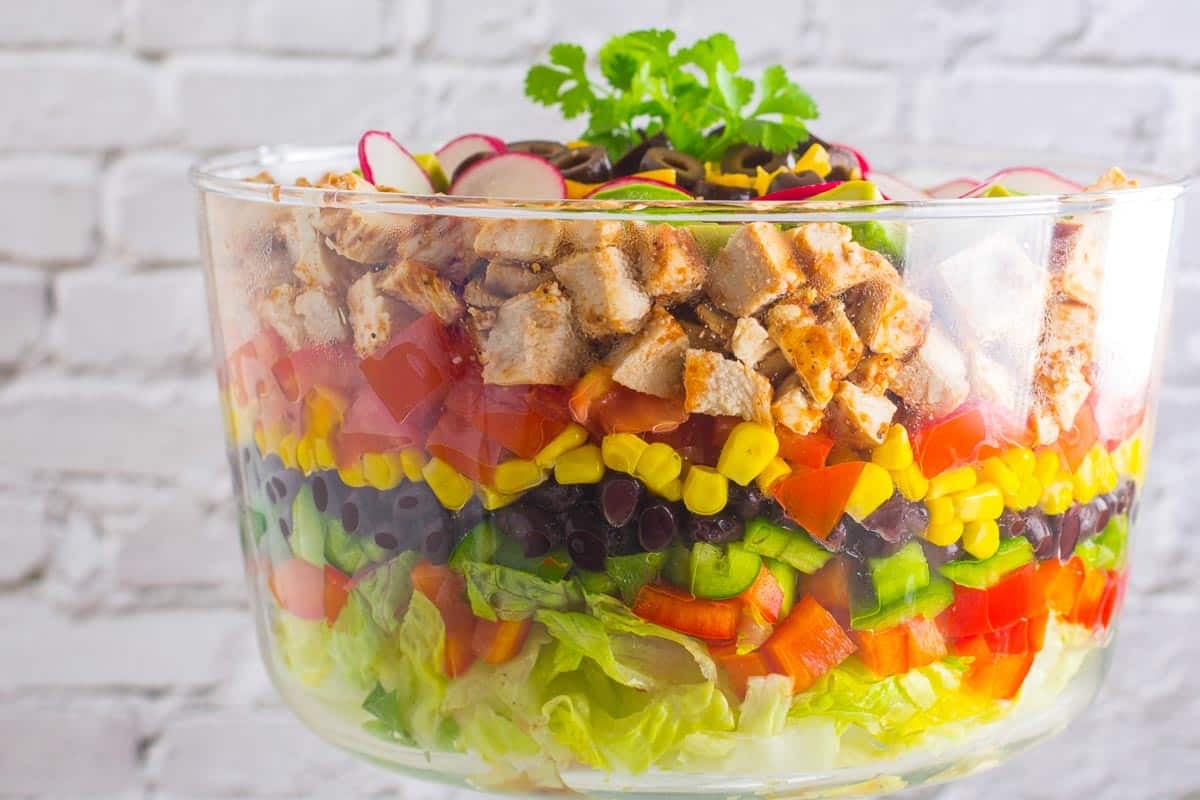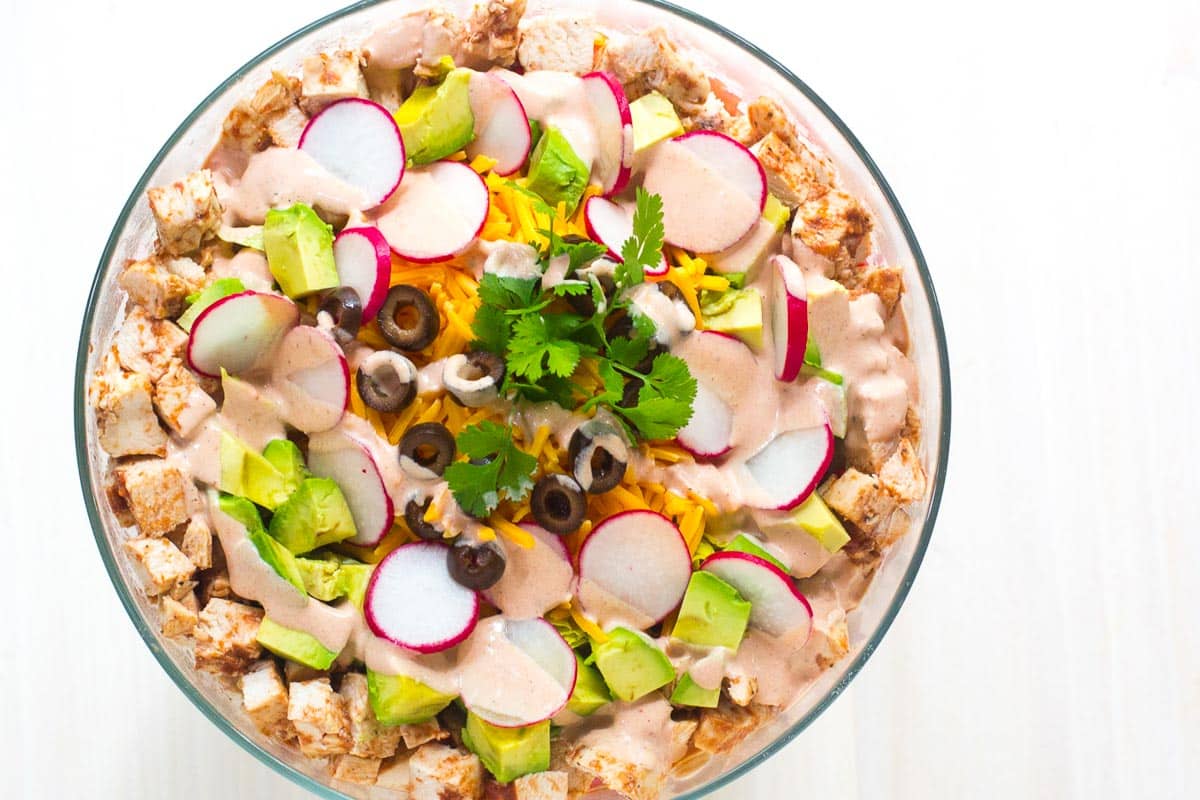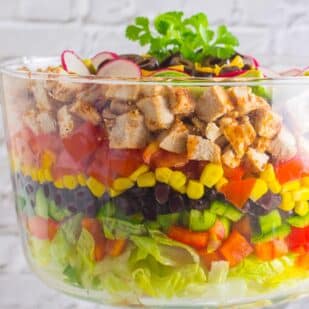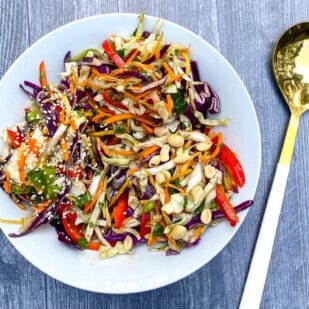Our Low FODMAP Chopped BBQ Chicken Salad is a delightful combination of chicken, tomatoes, avocado, black beans, corn, shredded cheese, and crisp, crunchy lettuce. It is accompanied by a creamy dressing made with our Low FODMAP Sweet & Sticky BBQ Sauce, mayonnaise, lactose-free sour cream and tangy lime juice. Textures, colors and flavor all in one!

Chopped salads consist of ingredients that are finely diced, making them convenient for on-the-go meals at work or school. We actually like eating them with a spoon.
This Low FODMAP Chopped BBQ Chicken Salad will make lunchtime special!
Many different corn based foods, as well as corn itself, have been lab tested for FODMAPs by both Monash University and FODMAP Friendly. In this case you want corn kernels, and we are using Monash lab data.
You could cut corn kernels off of the cob, in which case a low FODMAP serving size is 38 g, or about the amount removed from half a cob, according to Monash. Canned corn can be drained, in which case the low FODMAP serving size is 75 g, or 1 cup.
If you want to use fresh corn, use a sharp chef’s knife. Shuck the cob, hold it vertically on a cutting board and cut downwards at the base of the kernels to detach them from the cob. The corn will be consumed raw in the salad. All the juices are sweet and can be added to your dressing.
Chicken breasts are leaner, but thighs are juicer. It’s your choice!
Black beans have been lab tested and have a low FODMAP serving size of 40 g or about ⅙ cup, according to Monash University.
There is A LOT of confusion about whether avocado is low FODMAP. According to lab testing by Monash University it is low FODMAP in amounts of 30 g. We have much more info for you in our article, Is Avocado Low FODMAP? We suggest you read it! FODMAP Friendly lab tests had different results, which are explained in the article.
You don’t. You could arrange this salad any way you want. We like using a clear glass bowl to see all the layers, but you could toss it together for a whole other look.

FODMAP Information
All recipes are based upon Monash University & FODMAP Friendly science at time of initial publication.
- Avocados: Both Monash University and FODMAP Friendly have lab tested avocados, and their results vary from one another. Monash University lab testing reports that avocado is low FODMAP at 30 g, or what they call “an eighth of an avocado”; this volume amount means nothing, BTW. Avocados can vary from 3-ounces (85 g) a piece to over 2-pounds (910 g). GO BY WEIGHT – and the weight is for flesh only. Their details state that the avocados they tested contain sorbitol. FODMAP Friendly lab testing initially reported that avocados had a low FODMAP “Pass” at 120 g (4.23-ounces). The details stated that avocados tested contained mannitol, fructans and some excess fructose. FODMAP Friendly recently re-tested both ripe Hass avocado and unripe Hass avocado. The lab testing reports that both ripe and unripe get a “Pass” at 80g (2.82 ounces). Their details state that both the ripe and unripe avocados were low in all FODMAP groups, and in fact both ripe and unripe have a max low FODMAP serving size, as determined in the lab, to be 1000 g (that is not a typo). PLEASE read our article, Is Avocado Low FODMAP?
- Black Beans: Canned and drained beans have the lowest FODMAP contents. Both Monash University and FODMAP Friendly have lab tested black beans. FODMAP Friendly gives them a “Fail” at ½ cup (150 g) and we do not know if they were canned, whether they were drained or whether they were cooked from dry. Monash tells us that canned, drained black beans are Green Light low FODMAP at 40 g or about ⅙ cup.
- Cheese: Many cheeses have low FODMAP serving sizes. The low FODMAP diet is not a dairy-free diet. Hard cheeses such as Parmigiano Reggiano or Pecorino Romano have been lab tested by Monash University and are low FODMAP in 40 g amounts.
- Green Bell Peppers: Green bell peppers have been lab tested by Monash University and are recommended in low FODMAP amounts of ½ cup or 75 g (up from 52 g in former lab tests) Also, the FODMAP found switched from sorbitol initially to fructans in present tests. FODMAP Friendly has lab tested green bell peppers and states that 1 small pepper at 75 g is low FODMAP.
- Herbs: Many fresh and dried herbs have been lab tested by both Monash University and FODMAP Friendly and are easily looked up in the apps, which we strongly suggest that you have. The additional good news is that if you are interested in an herb that has not been lab tested, you can look at the nutritional panel and assess its FODMAP load for yourself. If the “Sugars” and/or “Carbs” are 1 g or less per serving, then the item would be a good bet to try.
- Lactose-Free Dairy: Lactose-free dairy, such as lactose-free milk or lactose-free cream cheese, has lactase enzyme added that breaks the disaccharide molecules and creates a more digestible dairy product, from a lactose perspective. The resulting product is not dairy-free, but it is lactose-free. Some products might have miniscule amounts of lactose remaining, but the amount is small enough for the product to be labeled as lactose-free. For instance, Breyers Lactose-Free Vanilla Ice Cream states it is 99% lactose-free, while Lactaid Vanilla Ice Cream states it is 100% lactose-free.
- Lettuce: Romaine lettuce has been lab tested by both Monash and FODMAP Friendly. Also labeled as cos lettuce on the Monash app, their lab tested determined a generous low FODMAP serving size of 2 cups (75 g). FODMAP Friendly gives it a “Pass” at 1 cup (75 g).
- Lime Juice: Monash University has lab tested lime juice and it is low FODMAP in 1 cup (250 g) amounts (double that of lemon juice, as an interesting fact).
- Mayonnaise: Both Monash University and FODMAP Friendly have lab tested mayonnaise. Monash has also tested a low fat version. They all agree that a low FODMAP serving size is 40 g or 2 Australian tablespoons (for low fat, too). Some mayonnaise can contain natural flavors that are derived from onion and/or garlic. Neither of the certifying bodies has told us if the mayonnaise they tested did or did not contain such ingredients. Certainly if garlic or onion are listed as line items on the label, you might look for a different brand.
- Red Bell Peppers: Red bell peppers have been lab tested by Monash University and have shown no detectable FODMAPs. FODMAP Friendly has lab tested red bell peppers and states that 1 small pepper at 75 g is low FODMAP. According to FODMAP Friendly, max serving size is 938 g. Upon re-testing, Monash lab tests showed a low FODMAP serving size of ⅓ cup or 43 g. Obviously these numbers are all over the place. Don’t fret. Simply use any of these numbers as a place to begin your exploration of FODMAPs. Also refer to our article on why these numbers differ.
- Red Radish: Both Monash University and FODMAP Friendly have lab tested red radishes. FODMAP Friendly gives them a “Pass” at 2 radishes (40 g).Monash states that no FODMAPs were detected upon lab testing and set a serving size at 4 radishes (75 g).
- Scallions: Monash University lab testing found no FODMAPs detected in scallion greens; they suggest a 75 g serving size. FODMAP Friendly has also lab tested scallions: their recommended serving size for the green parts is 16 g, with a max low FODMAP serving of 161 g. They have also tested the bulb and it is low FODMAP in 19 g portions, which is about 2 tablespoons finely chopped.
- Tomatoes: Both Monash University and FODMAP Friendly have lab tested several kinds of tomatoes, numerous times. In earlier lab tests for common, beefsteak tomatoes, Monash University stated that their lab tests showed no FODMAPs. In later tests (now called just “common tomato”), the results suggest about ½ medium tomato or 65 g are low FODMAP. FODMAP Friendly gives them a “Pass” at ½ cup (75 g) portions and suggests up to 84 g are low FODMAP. Earlier lab tests by Monash for Roma (plum) tomatoes stated low FODMAP servings of 75 g, which is about 1 small tomato or ½ cup. Later tests state 48 g are low FODMAP, or about 2/3 tomato. FODMAP Friendly recommends 75 g is low FODMAP, with a serving up to 108 g being low FODMAP. For Cherry tomatoes, earlier lab tests by Monash showed that 75 g of cherry tomatoes are low FODMAP (about 5 or ½ cup); later tests say 3 tomatoes or 45 g are low FODMAP. FODMAP Friendly states that 75 g are low FODMAP, with a max serve of 750 g being low FODMAP. Yes, these results are all over the map. Tomatoes vary hugely in sugar content, even variety to variety, and neither testing body has told us what varieties they tested. Use any of these accurate lab test results as a place to begin your exploration of your relationship to FODMAPs in tomatoes.
Please always refer to the Monash University & FODMAP Friendly smartphone apps for the most up-to-date lab tested information. Foods will be retested from time to time; in the case of raw ingredients, such as fruits and vegetables, results may vary. All lab tested results are valid and represent a snapshot in time. As always, your tolerance is what counts; please eat accordingly. The ultimate goal of the low FODMAP diet is to eat as broadly as possible, without triggering symptoms, for the healthiest microbiome.

Low FODMAP Chopped BBQ Chicken Salad
Our Low FODMAP Chopped BBQ Chicken Salad is a delightful combination of chicken, tomatoes, avocado, black beans, corn, and crisp, crunchy lettuce. It is accompanied by a creamy dressing made with our Low FODMAP Sweet & Sticky BBQ Sauce, mayonnaise, lactose-free sour cream and tangy lime juice. Textures, colors and flavor all in one!
Ingredients:
- 1 1/2- pounds (680 g) boneless, skinless chicken breasts or thighs
- 2/3 cup (165 ml) Low FODMAP Sweet & Sticky BBQ Sauce, divided
- 1 medium head Romaine lettuce, cored, finely shredded
- 2 medium beefsteak tomatoes, cored and chopped
- 1 ear fresh corn shucked; corn kernels removed from cob, to yield 75 g kernels
- 1 green bell pepper, cored and diced
- 1 red bell pepper, cored and diced
- 4- ounces (115 g) canned, drained black beans
- 4- ounces (115 g) shredded cheese, such as cheddar, pepper jack or Monterey Jack
- 6- ounces (170 g) avocado flesh, diced
- ¼ cup (40 g) sliced black olives
- ½ cup (32 g) chopped scallions, green parts only
- 3 red radishes, trimmed and sliced thinly crosswise
- Fresh cilantro
- 1/3 cup (75 g) mayonnaise
- 1/3 cup (80 g) lactose-free sour cream
- 1 teaspoon lime juice
- Hot sauce, as desired
- Kosher salt
- Freshly ground black pepper
Preparation:
-
Preheat oven to 375°F (190°C). Brush chicken breasts or thighs on both sides with ⅓ cup (75 ml) Low FODMAP Sweet & Sticky BBQ Sauce and place on a roasting pan. Roast for about 15 to 20 minutes or until cooked through. Cool and dice.
-
While the chicken is cooking, prep your other veggies and the dressing.
-
You can layer the vegetables and chicken any way you like. We saved portions of avocado, olives, radishes, and cilantro for garnish on the top.
-
For the dressing, whisk together the remaining BBQ Sauce with the mayonnaise, sour cream and lime juice. Season with a few drops of hot sauce, salt and pepper as desired. Serve the salad with the dressing offered on the side.
-
An alternative presentation is to toss everything together – chicken, vegetables and dressing – and serve that way. Your choice!
-
If you dress the salad, serve right away. If you want to pack it for lunch, or serve later, store the salad and dressing separately, both refrigerated, in covered containers up to 1 day.
Notes:
FODMAP Information
All recipes are based upon Monash University & FODMAP Friendly science at time of initial publication.
• Avocados: Both Monash University and FODMAP Friendly have lab tested avocados, and their results vary from one another. Monash University lab testing reports that avocado is low FODMAP at 30 g, or what they call “an eighth of an avocado”; this volume amount means nothing, BTW. Avocados can vary from 3-ounces (85 g) a piece to over 2-pounds (910 g). GO BY WEIGHT – and the weight is for flesh only. Their details state that the avocados they tested contain sorbitol. FODMAP Friendly lab testing initially reported that avocados had a low FODMAP “Pass” at 120 g (4.23-ounces). The details stated that avocados tested contained mannitol, fructans and some excess fructose. FODMAP Friendly recently re-tested both ripe Hass avocado and unripe Hass avocado. The lab testing reports that both ripe and unripe get a “Pass” at 80g (2.82 ounces). Their details state that both the ripe and unripe avocados were low in all FODMAP groups, and in fact both ripe and unripe have a max low FODMAP serving size, as determined in the lab, to be 1000 g (that is not a typo). PLEASE read our article, Is Avocado Low FODMAP?
• Black Beans: Canned and drained beans have the lowest FODMAP contents. Both Monash University and FODMAP Friendly have lab tested black beans. FODMAP Friendly gives them a “Fail” at ½ cup (150 g) and we do not know if they were canned, whether they were drained or whether they were cooked from dry. Monash tells us that canned, drained black beans are Green Light low FODMAP at 40 g or about ⅙ cup.
• Cheese: Many cheeses have low FODMAP serving sizes. The low FODMAP diet is not a dairy-free diet. Hard cheeses such as Parmigiano Reggiano or Pecorino Romano have been lab tested by Monash University and are low FODMAP in 40 g amounts.
• Green Bell Peppers: Green bell peppers have been lab tested by Monash University and are recommended in low FODMAP amounts of ½ cup or 75 g (up from 52 g in former lab tests) Also, the FODMAP found switched from sorbitol initially to fructans in present tests. FODMAP Friendly has lab tested green bell peppers and states that 1 small pepper at 75 g is low FODMAP.
• Herbs: Many fresh and dried herbs have been lab tested by both Monash University and FODMAP Friendly and are easily looked up in the apps, which we strongly suggest that you have. The additional good news is that if you are interested in an herb that has not been lab tested, you can look at the nutritional panel and assess its FODMAP load for yourself. If the “Sugars” and/or “Carbs” are 1 g or less per serving, then the item would be a good bet to try.
• Lactose-Free Dairy: Lactose-free dairy, such as lactose-free milk or lactose-free cream cheese, has lactase enzyme added that breaks the disaccharide molecules and creates a more digestible dairy product, from a lactose perspective. The resulting product is not dairy-free, but it is lactose-free. Some products might have miniscule amounts of lactose remaining, but the amount is small enough for the product to be labeled as lactose-free. For instance, Breyers Lactose-Free Vanilla Ice Cream states it is 99% lactose-free, while Lactaid Vanilla Ice Cream states it is 100% lactose-free.
• Lettuce: Romaine lettuce has been lab tested by both Monash and FODMAP Friendly. Also labeled as cos lettuce on the Monash app, their lab tested determined a generous low FODMAP serving size of 2 cups (75 g). FODMAP Friendly gives it a “Pass” at 1 cup (75 g).
• Lime Juice: Monash University has lab tested lime juice and it is low FODMAP in 1 cup (250 g) amounts (double that of lemon juice, as an interesting fact).
• Mayonnaise: Both Monash University and FODMAP Friendly have lab tested mayonnaise. Monash has also tested a low fat version. They all agree that a low FODMAP serving size is 40 g or 2 Australian tablespoons (for low fat, too). Some mayonnaise can contain natural flavors that are derived from onion and/or garlic. Neither of the certifying bodies has told us if the mayonnaise they tested did or did not contain such ingredients. Certainly if garlic or onion are listed as line items on the label, you might look for a different brand.
• Red Bell Peppers: Red bell peppers have been lab tested by Monash University and have shown no detectable FODMAPs. FODMAP Friendly has lab tested red bell peppers and states that 1 small pepper at 75 g is low FODMAP. According to FODMAP Friendly, max serving size is 938 g. Upon re-testing, Monash lab tests showed a low FODMAP serving size of ⅓ cup or 43 g. Obviously these numbers are all over the place. Don’t fret. Simply use any of these numbers as a place to begin your exploration of FODMAPs. Also refer to our article on why these numbers differ.
• Red Radish: Both Monash University and FODMAP Friendly have lab tested red radishes. FODMAP Friendly gives them a “Pass” at 2 radishes (40 g).Monash states that no FODMAPs were detected upon lab testing and set a serving size at 4 radishes (75 g).
• Scallions: Monash University lab testing found no FODMAPs detected in scallion greens; they suggest a 75 g serving size. FODMAP Friendly has also lab tested scallions: their recommended serving size for the green parts is 16 g, with a max low FODMAP serving of 161 g. They have also tested the bulb and it is low FODMAP in 19 g portions, which is about 2 tablespoons finely chopped.
• Tomatoes: Both Monash University and FODMAP Friendly have lab tested several kinds of tomatoes, numerous times. In earlier lab tests for common, beefsteak tomatoes, Monash University stated that their lab tests showed no FODMAPs. In later tests (now called just “common tomato”), the results suggest about ½ medium tomato or 65 g are low FODMAP. FODMAP Friendly gives them a “Pass” at ½ cup (75 g) portions and suggests up to 84 g are low FODMAP. Earlier lab tests by Monash for Roma (plum) tomatoes stated low FODMAP servings of 75 g, which is about 1 small tomato or ½ cup. Later tests state 48 g are low FODMAP, or about 2/3 tomato. FODMAP Friendly recommends 75 g is low FODMAP, with a serving up to 108 g being low FODMAP. For Cherry tomatoes, earlier lab tests by Monash showed that 75 g of cherry tomatoes are low FODMAP (about 5 or ½ cup); later tests say 3 tomatoes or 45 g are low FODMAP. FODMAP Friendly states that 75 g are low FODMAP, with a max serve of 750 g being low FODMAP. Yes, these results are all over the map. Tomatoes vary hugely in sugar content, even variety to variety, and neither testing body has told us what varieties they tested. Use any of these accurate lab test results as a place to begin your exploration of your relationship to FODMAPs in tomatoes.
Please always refer to the Monash University & FODMAP Friendly smartphone apps for the most up-to-date lab tested information. Foods will be retested from time to time; in the case of raw ingredients, such as fruits and vegetables, results may vary. All lab tested results are valid and represent a snapshot in time. As always, your tolerance is what counts; please eat accordingly. The ultimate goal of the low FODMAP diet is to eat as broadly as possible, without triggering symptoms, for the healthiest microbiome.
Nutrition
All nutritional information is based on third-party calculations and should be considered estimates. Actual nutritional content will vary with brands used, measuring methods, portion sizes and more. For a more detailed explanation, please read our article Understanding The Nutrition Panel Within Our Recipes.







